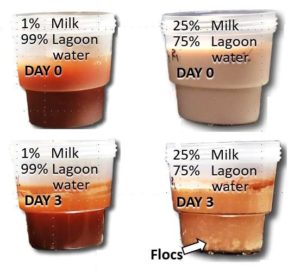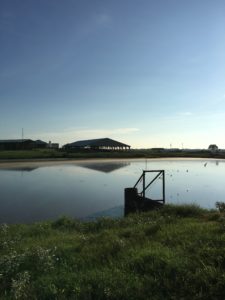How do you dispose of large volumes of milk properly? It is against federal and most state environmental regulations including Texas, to dump milk into surface water or on any non-permeable surfaces. When dumped, nutrients in milk could negatively affect water quality by enhancing algal blooms, which reduce oxygen levels, potentially killing fish and other aquatic organisms. Nutrients overloads and algae blooms may also emit foul-smelling compounds creating an odor concern for nearby communities. When there is no other option, excess milk may be composted with manure, disposed into manure or wastewater storage lagoons or land applied on crop fields. Regulations regarding these practices differ for each state. For example, the state of Wisconsin regulates land application of milk in the same way as land application of process wastewater and does not require additional approval to add milk into manure storages. The milk and manure mixture may be land-applied in accordance with the nutrient management plan. On the other hand, Texas allows compost milk with manure if operation is permitted and equipped for onsite composting. Regarding discharging milk into waste streams including manure/wastewater storage lagoons and application milk to agricultural fields, Texas Commission on Environmental Quality (TCEQ) may consider exercising its enforcement discretion and review requests when noncompliance is unavoidable directly due to impact from the coronavirus. Please refer to TCEQ’ page for more guidance. In addition to regulation considerations, public announcement and negotiation with surrounding communities are likely needed when tank loads of milk must be spread over large areas of fields.
Composting Milk in Manure Piles
CAFO facilities in Texas may compost milk with manure if their authorization allows composting onsite, provided it is done in accordance with 30 Texas Administrative Code Chapter 332. When allowed by regulations, the amount of milk added to compost piles must be carefully controlled. Excessive amount of milk will likely disrupt the composting process by introducing nitrogen to carbon ratio higher than ideal composting condition. Extra care and supervision about containment of additional leachate and run-off, as well as employing adequate cover for odor control should be provided.
Disposing Milk to Wastewater Lagoons
When using both direct land-application and lagoon discharge are allowed by regulation, it is preferable to add the milk into the wastewater – lagoon (lagoon), let the microbes in the lagoon decompose the milk, and land-apply the wastewater/milk mixture. The quantity of milk that can be discharged into the lagoon depends on the lagoon type, daily amount of wastewater entering the lagoon, the lagoon wastewater level, and the climate. Milk contains higher levels of volatile solids but has a lower pH than typical process wastewater (Table 1). However, milk’s characteristics will be affected during long term storage. Spoilage lowers milk pH and organic nitrogen can be turned into inorganic nitrogen which is more susceptible to be lost as ammonia. Adding too much milk to the lagoon might disrupt the lagoon microbe’s equilibrium, reducing their capability of breaking down volatile organics, which may lead to lagoon odor problems or even lagoon failures. Adding milk between longer intervals between each event or adding multiple smaller amounts of milk will allow a gradual microbial degradation of waste milk.
Milk contains high levels of nitrogen (N), phosphorus (P), and potassium (K). When land applied, most of the N, P and K from milk are easily degraded by soil microorganisms to make them readily available for plant uptake. The levels of N, P and K in milk are usually a magnitude higher than in diluted manure (containing ~ 2% solids) in these processing lagoons. In addition, the ratio of N to P in milk is lower than that of dairy process wastewater, which may cause high P levels in soil receiving milk. For milk discharged into lagoons, our calculation tool is available to estimate the nutrient level of the wastewater/milk mixture.
Table 1: Nutrient and pH of milk and dairy lagoon wastewater.
1000 gal Milk |
1000 gal Lagoon Wastewater* |
|
Total solids |
~1000 lb |
>176 lb |
Volatile solids |
~ 990 lb |
>150 lb |
Total Nitrogen |
~46 lb |
~1.0 lb |
Total Phosphorus |
~11 lb |
~0.1 lb |
Total Potassium |
~14 lb |
~1.4 lb |
pH |
6.5-6.7 |
8.0-10.0 |
* Estimation for a typical anaerobic dairy lagoon processing diluted manure (~2% solids)
Land Application of Milk or Milk-Wastewater Mixture
If allowed by regulators to use this method, land application of milk or milk-wastewater mixture must also consider rate, timing, and placement to minimize environmental risks. Based on current research, milk itself can improve soil health if applied properly. This is because milk provides nutrients to plants and stimulates the growth of beneficial saprophytic fungi by supplying sugar. A thriving saprophyte community is usually indicated by white mold on the soil surface. To safely and effectively land apply milk, the rate of milk application must be calculated based on the nutrient value. Nutrients in milk will contribute to other forms of nutrients that have been already applied, as well as those from wastewater lagoons. Timing and location of spread must be chosen to avoid application on regions having excessively wet soil, steep slopes, or other high-risk areas for leaching, runoff, and erosion. All applications shall be applied in accordance with the dairy’s nutrient management plan with adequate buffers from surface water and potential groundwater recharge features. Dividing a single application into multiple smaller applications is an effective strategy to reduce environmental risks. Injecting or incorporating the milk/waste mixture into the soil profile rather than on the surface of the soil also minimizes the chances of runoff.
Steps must be taken to prevent crop damage when milk and milk-wastewater mixtures are applied to a field. If nutrients applied in excess of the crops’ nitrogen need, it can lead to increased incidence of lodging, vegetative growth, and diseases, as well as increasing the opportunity for runoff and leaching into nearby water bodies. Irrigating milk onto plant leaves should be avoided in order to prevent dry milk to form on forage. If milk is spoiled, pH may be lower than in fresh milk. Any material with pH lower than 3 could be lethal to vegetation. The effect of milk may vary by crops. Consult a crop expert to determine which crop could be applied with milk.
Odor Concerns When Land Appling Milk or Milk-Wastewater Mixture
Disposed milk may emit odorous compounds when decomposing in the field. The smell of decaying milk can be strong, which usually cannot be covered by masking agents. The odor risk could be greatly reduced if milk is applied to lagoon and allowed time for sufficient decomposition before it is applied. Milk may be applied during windy weather to disperse odors before they reach neighbor’s nose. On the contrary, during calm weather, odors attached to airborne particles may be carried by gravity to impact community at low elevation spots. It is recommended to degrade and stabilize milk in a lagoon to reduce odor follow the recommendations discussed previously to make sure the lagoon function is carefully maintained. Direct injection of the milk into the soil profile also reduces the chances for odor emission
Zong Liu, Ph.D.
Assistant Professor & Extension Specialist
Biological & Agricultural Engineering
Texas A&M University
Office: (979) 458-0354
Educational programs of the Texas A&M AgriLife Extension Service are open to all people without regard to race, color, sex, religion, national origin, age, disability, genetic information, or veteran status. Issued in furtherance of Cooperative Extension Work in Agriculture and Home Economics, Acts of Congress of May 8, 1914, as amended, and June 30, 1914, in cooperation with the United States Department of Agriculture, Jeff Hyde, Director, Texas A&M AgriLife Extension Service, The Texas A&M University System


